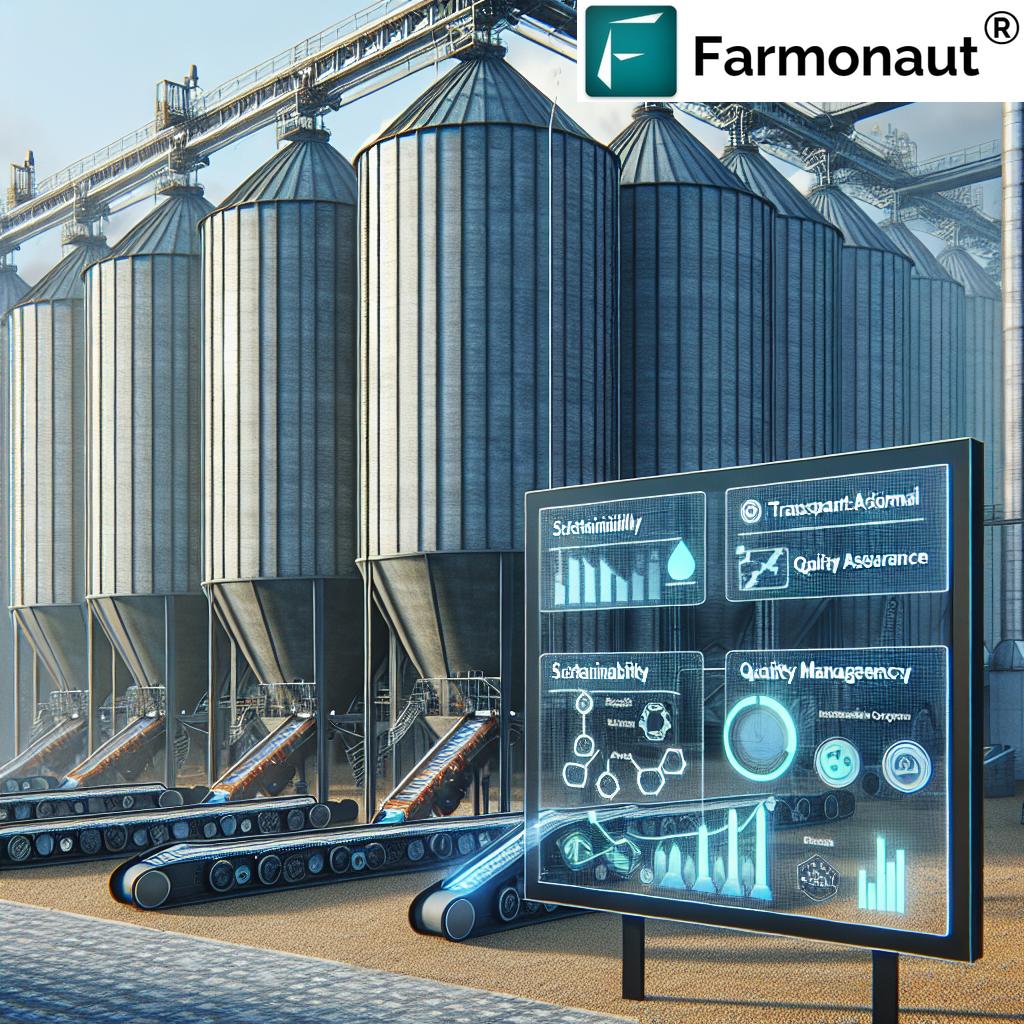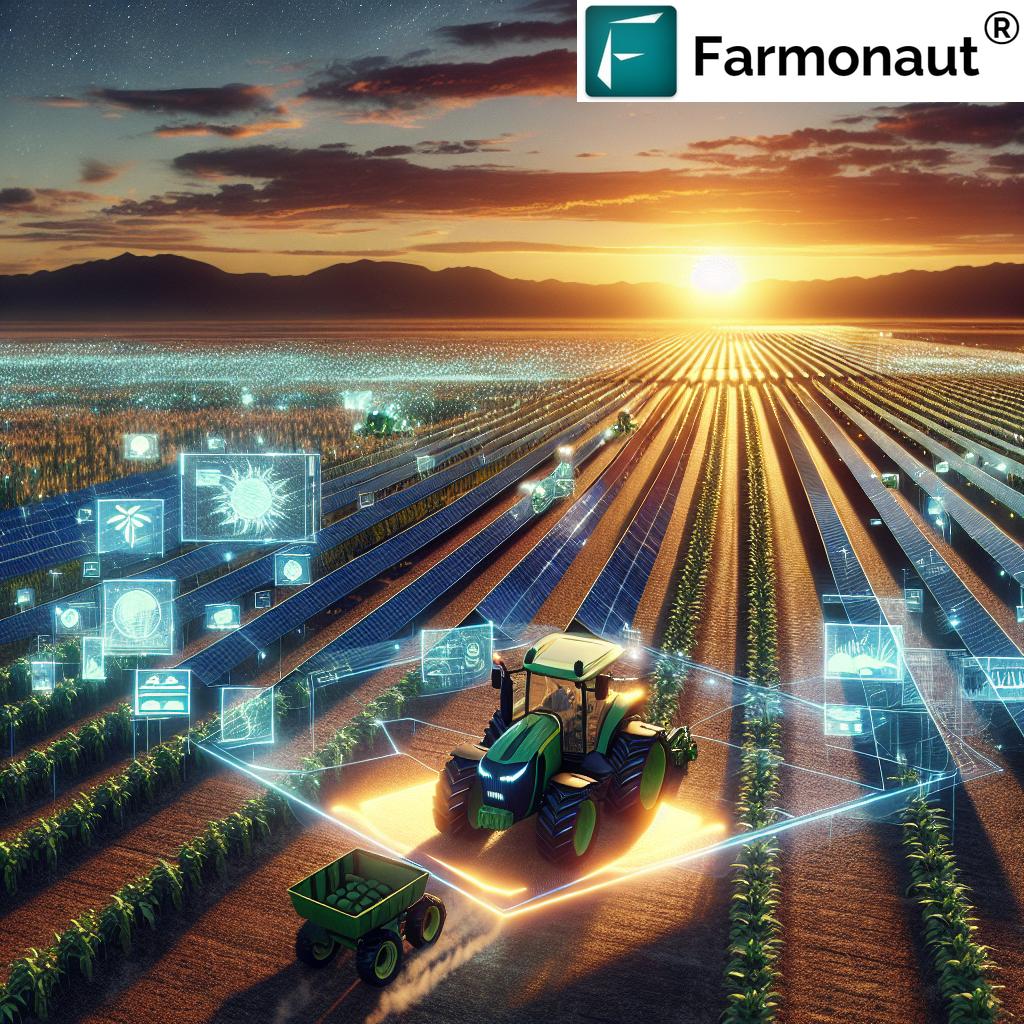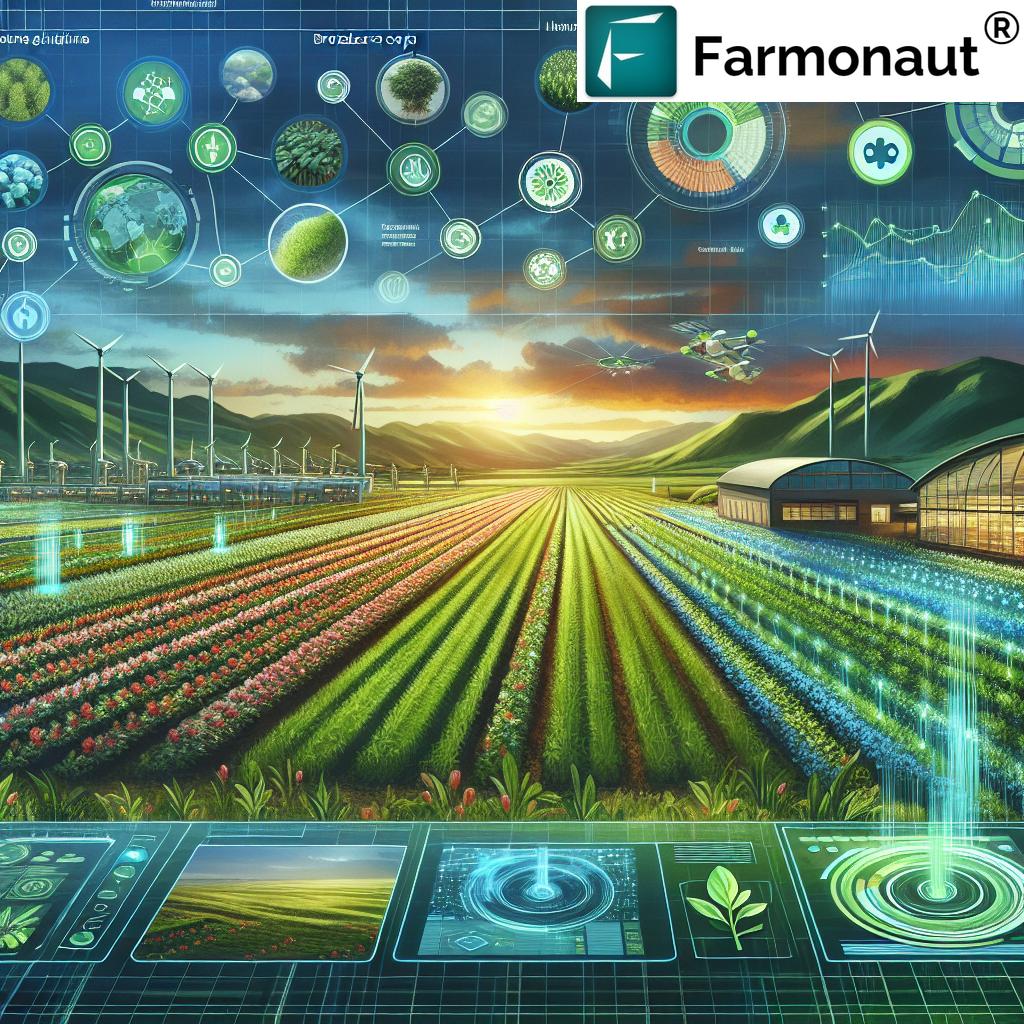ERP for Aerospace: Boost Efficiency & Compliance Fast
“Over 70% of aerospace firms report improved compliance after adopting ERP systems for resource management and traceability.”
“ERP adoption in agriculture can increase operational efficiency by up to 30%, driving sector-wide sustainability advancements.”
Table of Contents
- Introduction: The Convergence of ERP & Efficiency
- Understanding ERP Systems in Modern Resource Management
- The Need for ERP in Agriculture, Farming, and Forestry
- Key Benefits of ERP Systems in Agriculture
- ERP for Aerospace: Comparative Feature Table vs. Traditional Methods
- Implementing ERP: Lessons from Agriculture
- Farmonaut’s Paradigm Shift in Agricultural Resource Management
- Future Outlook: ERP, Sustainability & Industry 4.0
- Frequently Asked Questions (FAQs)
- Farmonaut Subscription Plans
- Conclusion
Introduction: The Convergence of ERP & Efficiency
Enterprise Resource Planning (ERP) systems are transforming industries—integrating workflows, enhancing efficiency, and fostering compliance. Now, this wave of technological advancement is sweeping across aerospace, agriculture, farming, and forestry; sectors that depend on robust resource management and traceability for competitive advantage, operational resilience, and sustainability.
While ERP solutions have long been the backbone of manufacturing and supply chain industries, more recently there has been a remarkable adoption within agriculture—an area once reliant solely on traditional methods. Insights from sector-wide integration reveal that the benefits of ERP in agriculture, including precision resource management, seamless traceability, and real-time insights, are almost directly translatable to aerospace and related high-compliance fields.
This article examines the concept, implementation, and transformative impact of ERP for aerospace, highlighting advantages like boosted efficiency and compliance—backed by proven improvements from ERP’s success in agricultural resource management systems. Real-world applications, lessons from Farmonaut’s digital transformation of farm management, and actionable strategies for cross-industry ERP adoption will also be covered.
Understanding ERP Systems in Modern Resource Management
At its core, an ERP system is a comprehensive suite of integrated applications designed to manage, optimize, and automate core business processes. These include procurement, production, sales, finance, human resources, compliance tracking, and more. By centralizing data and automating workflows, ERP systems deliver:
- Seamless cross-departmental data flow and collaboration
- Unified and secure record management
- Real-time insights and analytics for informed decision-making
- Efficiency improvements and reduction in manual errors
- Simplified regulatory compliance and audits
For sectors like aerospace and agriculture, these benefits address unique challenges:
- Highly regulated operating environments (compliance, traceability, labor and environmental standards)
- Complex, multi-layered supply chains
- Persistent requirements for sustainability and transparency
- Dependency on diverse and often globally distributed resources
- Traditional process inefficiencies and data silos
ERP for Agriculture: Key Applications and Insights
“ERP for agriculture” exemplifies how technology modernizes resource allocation, improves traceability, and boosts efficiency from farm to market. Solutions such as Farmonaut’s Agro Admin App for large scale farm management showcase how satellite data, real-time analytics, and AI-led advisory systems can revolutionize crop management, fleet utilization, and sustainability practices. Similarly, blockchain-based traceability solutions ensure that every agricultural product’s journey is tracked transparently, addressing consumer demands for responsible sourcing and quality.
The cross-industry relevance is clear: aerospace firms, like their agricultural counterparts, stand to dramatically benefit from centralized, integrated resource management—cutting compliance overhead, improving reporting accuracy, and supporting operational agility.
The Need for ERP in Agriculture, Farming, and Forestry
Both aerospace and agricultural sectors operate in environments marked by extreme complexity, tight regulations, and a growing emphasis on environmental sustainability. However, traditional management methods often result in:
- Redundant manual effort and high likelihood of error
- Slow, opaque compliance processes
- Scattered or incomplete resource tracking data
- Difficulty in scaling or automating operations
- Poor traceability in critical supply chains
The shift to agriculture ERP solutions and forestry management system platforms is driven by a desire to replace inefficient, siloed systems with integrated digital solutions. Some sector-specific pain points include:
- Resource Management: Inefficient labor allocation, equipment downtime, and wastage of raw materials.
- Supply Chain Complexity: Multi-stakeholder environments with unclear product origin or status.
- Compliance and Audit: High administrative burdens from regulatory reporting and traceability requirements.
- Sustainability Challenges: Pressures to reduce emissions, implement sustainable practices, and demonstrate environmental stewardship.
Implementing an ERP solution brings scalable, data-driven management tools to these challenges—streamlining workflows, ensuring up-to-date compliance, and centralizing the resource footprint for maximum efficiency.
Sector Spotlight: How ERP Powers Agricultural Innovation
In agriculture and forestry, digital transformation is not just about growth—it’s about survival in an era of labor shortages, land degradation, and rapidly changing regulations. The agricultural resource management system (ARMS) exemplifies this transformation, optimizing everything from fleet management to product traceability.
- Modern carbon footprinting tools support compliance with global sustainability standards and climate targets.
- Fleet and equipment tracking ensures every resource is utilized efficiently, minimizing downtime and reducing operational costs.
- API-driven insurance and loan verification supports rapid, secure access to financial products—driven by centralized ERP data.
Key Benefits of ERP Systems in Agriculture
Lessons from ERP implementation in agriculture and forestry provide a blueprint for other complex, resource-intensive industries—especially aerospace. Let’s explore the primary benefits realized from the wide adoption of “ERP for agriculture” and “forestry management systems”:
-
Advanced Resource Management
From labor deployments to the allocation and utilization of equipment and materials, ERP platforms automate and synchronize resource management—cutting waste and boosting output.
With real-time dashboards, managers can track resource usage, receive alerts on shortages or overuse, and schedule optimal deployment across locations. This leads to improved yield, reduced downtime, and lower costs. -
Agriculture Supply Chain Optimization
The agricultural supply chain is notoriously complex, involving growers, logistics, processors, distribution networks, and retailers. ERP systems centralize every node in this chain, supporting:
- Inventory management, ensuring stock is distributed and replenished based on live data
- Transparent, automated logistics for both incoming and outgoing products
- Automated compliance and shipment documentation
- Integrated quality control and product status updates
-
Regulatory Compliance and Automated Record-Keeping
Increasing regulatory scrutiny elevates the need for accurate, accessible records and real-time traceability. ERP platforms generate audit trails automatically, allowing businesses to demonstrate compliance with:
- Food safety (GAP, HACCP, local guidelines)
- Environmental and labor laws
- Sustainability certifications and reporting (for carbon, water usage, biodiversity)
-
Data-Driven Decision Making
Timely decisions are critical in sectors like agriculture and aerospace where conditions shift rapidly. By centralizing operational, market, and financial data, ERP systems provide analytical tools for performance monitoring, anomaly detection, and scenario planning, leading to greater agility and profitability.
-
Sustainability and Traceability in Agriculture
Modern consumers and regulators increasingly demand transparency. ERP platforms equipped with blockchain, IoT integration, and AI mapping enable end-to-end traceability in agriculture—tracking every item from production to final sale.
- Demonstrating sustainable farming practices and validating sustainability claims
- Earning trust from environmentally conscious stakeholders
- Enabling rapid and traceable recall in the event of safety breaches
Each of these improvements can be mirrored in high-compliance sectors like aerospace, where error reduction, traceability, and operational security are non-negotiable.
Our experience shows that, whether managing aviation hardware or optimizing agricultural input cycles, the advantages of automation in farming operations and aerospace manufacturing are exceptionally similar—resulting in higher efficiency, improved compliance, and robust sustainability reporting.
ERP for Aerospace: Comparative Feature Table vs. Traditional Methods
Aerospace operations present some of the world’s toughest compliance, traceability, and resource allocation challenges. The following table contrasts key aspects of aerospace resource management and compliance using traditional methods and with an ERP for aerospace solution—accentuating advancements with lessons learned from ERP’s modernizing impact in agriculture.
| Aspect | Traditional Methods | ERP for Aerospace | Benefit (%) |
|---|---|---|---|
| Resource Management | 30+ manual hours/week; 15% misallocation rate; high idle time | 10 hours/week; 95% allocation accuracy; automated scheduling | ~67% time saved >50% reduction in errors |
| Traceability | Decentralized, paper-based; tracebacks take days/weeks | Digital, blockchain-enabled; instant traceability (minutes) | >90% faster tracebacks 100% digital records |
| Compliance (Audit Readiness) | Recurring delays (avg. 10 days); manual collating of documents | Live compliance dashboards; auto-generated reports; immediate access | >80% faster compliance resolution |
| Operational Efficiency | Multiple manual entries, frequent redundant tasks | Automated workflows; reduced duplication; streamlined approvals | >40% boost in efficiency |
| Sustainability Impact | Manual emission records; inconsistent sustainability reporting | Automated carbon tracking; real-time sustainability metrics | >60% improvement in sustainability reporting accuracy |
Summary: ERP for aerospace achieves dramatic increases in compliance speed, traceability, and efficiency compared to traditional manual or paper-based methods—paralleling the digital revolution ongoing in agriculture, farming, and forestry.
“ERP adoption in agriculture can increase operational efficiency by up to 30%, driving sector-wide sustainability advancements.”
Implementing ERP: Lessons from Agriculture
Successful ERP implementation requires a structured approach—balancing the unique requirements of each sector with tried-and-tested strategies for digital transformation. Here’s how agricultural best practices can inform ERP adoption in aerospace and adjacent high-compliance domains:
- Customization: Off-the-shelf solutions often need adaptation. For instance, agriculturally focused ERPs prioritize IoT device integration and supply chain traceability, while aerospace ERPs must incorporate aviation-grade compliance standards and maintenance schedules.
- Seamless Integration: Agricultural ERP platforms lead the field in tech integration—connecting satellite imagery, weather forecasting APIs, farm management software, and blockchains. Aerospace ERP can do the same by linking to digital twins, maintenance tracking systems, and real-time sensor data.
- Human-Centric Training and Change Management: Both sectors experience organizational resistance to new tech. Thorough staff training and transparent change management are essential for gaining buy-in and ensuring system success.
- Security and Regulatory Assurance: Agricultural data is highly sensitive (financials, crop yields, proprietary practices)—mirroring aerospace’s need to safeguard design IP, operational records, and compliance documentation. Prioritize robust digital security frameworks.
- Scalability: ERP’s cloud-based approach—adopted by modern farm management software—makes scaling operations simple as data volumes, user numbers, or geographic spread increase.
API access—as available in platforms like Farmonaut’s Satellite and Weather API—accelerates digital transformation by allowing seamless data exchange between the ERP, field equipment, and third-party compliance modules. Review developer documentation here for technical integration.
Farmonaut’s Paradigm Shift in Agricultural Resource Management
As a pioneering agricultural technology company, Farmonaut offers a compelling case study in next-generation digital resource management. Our platform (accessible via Android, iOS, web app, and APIs) demonstrates how integrated, scalable ERP concepts enable affordable precision agriculture globally.
Key Innovations from Farmonaut:
- Satellite-Based Crop Health Monitoring: We leverage cutting-edge multispectral satellite imagery to provide granular field insights—enabling efficient irrigation, input management, and early intervention for pest or disease issues.
- Jeevn AI Advisory System: Our real-time, AI-driven advisory delivers tailored weather forecasts, crop management strategies, and operational alerts for increased farm productivity.
-
Blockchain for Traceability in Agriculture: By documenting each stage of production on a tamper-proof ledger, we guarantee product authenticity and origin to both businesses and consumers—an approach equally valuable in aerospace component traceability.
Learn more about data-driven product tracking at our Product Traceability Page. -
Fleet and Resource Management: We empower agribusinesses to maximize fleet utilization, reduce operational costs, and centralize control over machinery and equipment.
Details on advanced asset management can be found here. -
Real-Time Carbon Footprinting: Our platforms automatically calculate emissions, supporting climate responsibility and regulatory reporting.
Review our Carbon Footprinting solution.
Our platform is an integrated agricultural platform—making advanced ERP-like functionality available to farms and cooperatives of any size or location. With pricing designed for individual farmers to government-scale deployments, the same principles of data-driven, sustainable development extend across all users.
- Learn More: Explore comprehensive forest and crop advisory tools for sustainability and compliance: Farmonaut Plantation & Forest Advisory
The same technologies driving agriculture forward—including AI, automation, IoT, blockchain, and seamless digital integration—are transforming aerospace, automotive, and other compliance-heavy industries.
Future Outlook: ERP, Sustainability & Industry 4.0
The future of ERP in both agriculture and aerospace lies in ongoing convergence with disruptive Industry 4.0 technologies:
- Cloud, IoT, and Real-Time Devices: Empower dynamic scheduling, instant inventory updates, predictive maintenance, and rapid compliance reporting in both fields.
- AI and Machine Learning: Enable anomaly detection, demand forecasting, supply optimization, and efficient resource planning at unprecedented scale.
- Blockchain and Security: Guarantee trust with tamper-proof traceability and encryption—vital for both global agricultural and aerospace supply chains.
- Sustainability Reporting: Automated measurement and reporting of carbon, water, and energy use are fast becoming regulatory requirements. Industry leaders adopt digital tools to stay ahead and meet ESG mandates.
- Mobile Accessibility: Solutions like Farmonaut’s Mobile & Web Apps make it possible for users anywhere to track, manage, and make data-driven decisions in real time.
The trend is clear: organizations slow to digitize will struggle with rising compliance costs, inefficiency, and reputational risk—while those that embrace ERP for aerospace and agriculture will unlock new value and future-proof their operations.
Frequently Asked Questions (FAQs)
What is ERP?
ERP (Enterprise Resource Planning) is a suite of integrated software applications that centralize and automate business processes—ranging from procurement and supply chain to compliance, finance, and resource management.
How does ERP benefit the aerospace sector?
ERP for aerospace streamlines resource management, guarantees real-time traceability, automates compliance, and increases efficiency—leading to faster operations, reduced errors, and robust sustainability reporting.
What are “ERP for agriculture” and “agricultural resource management system”?
These are ERP systems tailored for the agricultural industry. They optimize everything from crop monitoring and inventory to fleet management, compliance, traceability, and sustainability practices, using real-time data from IoT, satellites, and APIs.
How does traceability function in ERP?
ERP achieves traceability via centralized digital records, real-time updates, and blockchain integration—making it easy to track every product or component from origin to delivery, crucial in sectors like food and aerospace.
How does Farmonaut make precision agriculture accessible?
By integrating satellite monitoring, AI advisory, blockchain traceability, and scalable subscription models, Farmonaut democratizes access to advanced farm management and sustainability tools for every type of farm or supporter.
Is ERP scalable for both small farms and global aerospace operations?
Yes. The modern ERP, especially in cloud-native and app-based architectures like Farmonaut’s, provides modular, scalable features to serve users from individual farmers up to multinational supply chain managers.
What security features should an ERP system have?
Data encryption, multi-factor authentication, permissioned access, robust data backups, and (when needed) blockchain verification—essential for protecting financial, operational, and compliance records.
Where can I learn about Farmonaut’s API and integration options?
Visit our API Page and developer documentation for resources on integrating satellite and weather data into your management system.
Farmonaut Subscription Plans
Explore affordable and scalable Farmonaut subscription plans, designed to support every stage of your precision agriculture or large-scale farm management journey:
Conclusion
ERP systems have emerged as transformative tools—streamlining resource management, ensuring traceability, automating compliance, and enabling real-time insights for decision-makers. The lessons from ERP for agriculture, driven by practical innovations like those from Farmonaut, offer a clear pathway for highly regulated industries such as aerospace to overcome operational challenges and prepare for a sustainable, data-driven future.
Whether your goals are regulatory compliance, operational efficiency, transparent supply chains, or sustainable development, now is the time to evaluate and embrace integrated ERP systems. By learning from both agriculture and aerospace—and leveraging advanced technology, automation, and analytics—your organization can lead in the era of digital transformation.
Get started with modern, accessible, and integrated agricultural management today via our Web, Android, or iOS Apps.


















